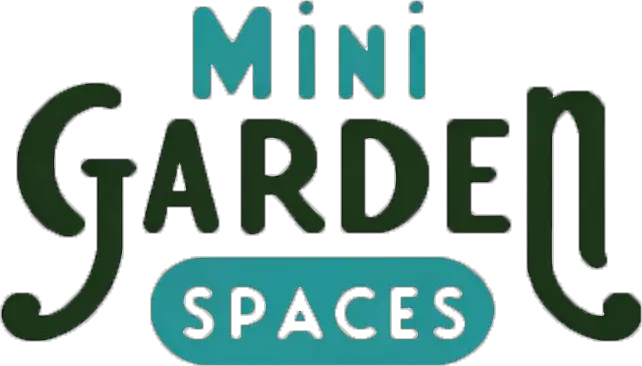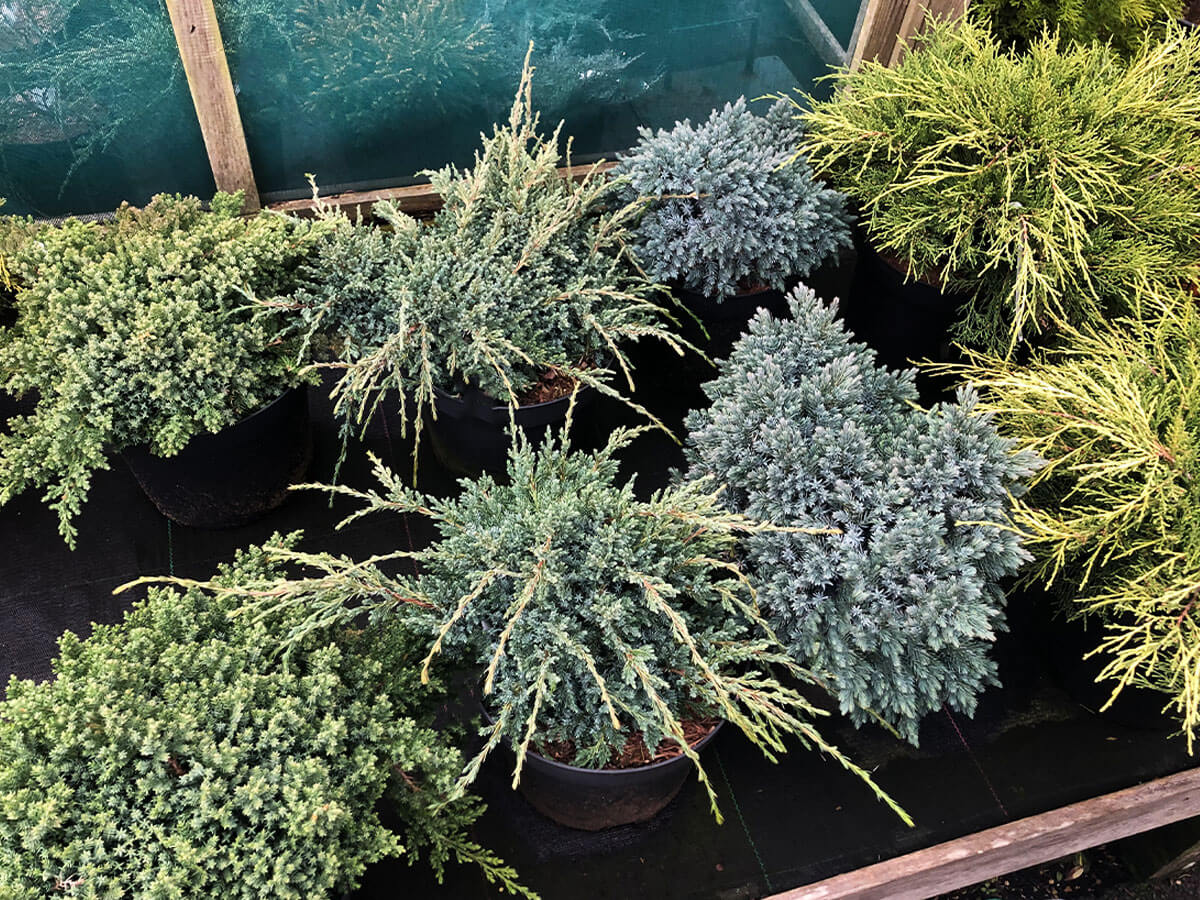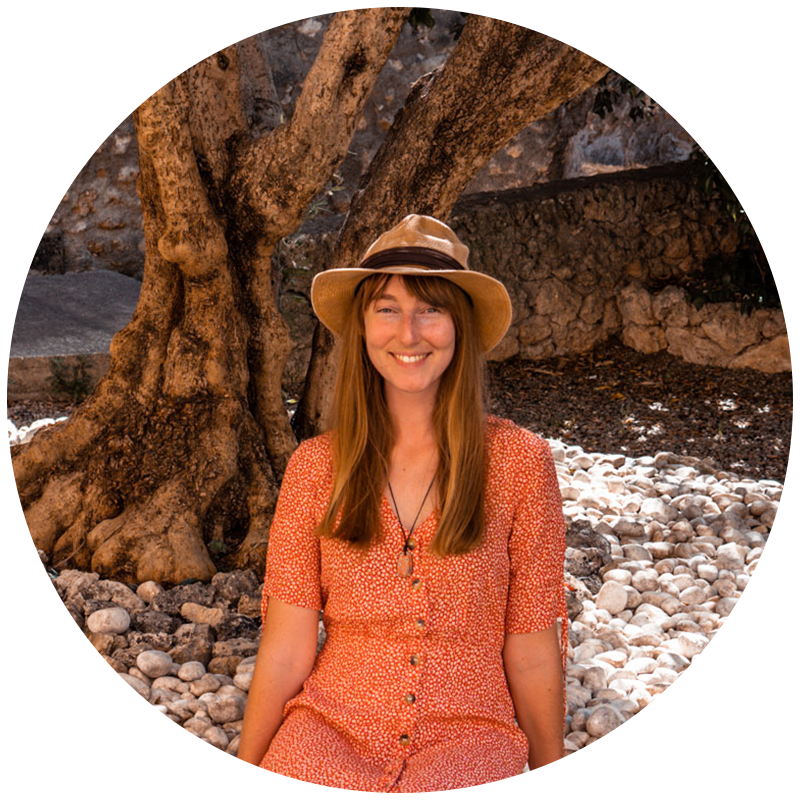12 Best Dwarf Conifers for Small Garden Spaces
December, 2022 |In a small garden, where every square foot counts, dwarf conifers can be a great space-saving option to bring color and interest. Often overlooked for bold flowers or shrubs, dwarf conifers are fantastic for bringing year-round color and texture to a small garden, especially in winter.
Available in a range of shapes, textures, and colors, dwarf conifers can really brighten up a small garden space. And as your other plants die back and lose their flowers or leaves, the evergreen sprays of dwarf conifer foliage can provide screening and vibrant color as winter sets in. They really are one of my favorite groups of evergreen plants to bring color in winter.
Related Read | 6 Surprising Benefits of Evergreens in a Small Garden

Most wild conifer species are usually too wide or too tall to add to a small garden. But as mini cultivars, dwarf conifers give you all the amazing textures and colored sprays of pine and juniper trees, but in a more manageable size!
Do dwarf conifers stay small?
Yes. Compared to other conifers, dwarf conifers will reach maturity at a shorter height, so they will stay small and compact. Typically, dwarf conifers have a maximum height of no more than 4-5ft, with most reaching maturity at about 3ft. Plus, like all conifers, they grow slowly too, gaining about an inch or two in size each year.
Because of their small size, they work well as feature plants in borders or simply as standalone plants in containers. You can even use dwarf conifers as shrubs to create short hedges.
How to keep dwarf conifers small
If your space is really limited, you can keep dwarf conifers in smaller containers to help them stay small. A smaller container will reduce root growth and ultimately restrict how big dwarf conifers will grow.
The best dwarf conifers for a small garden space
Here are some of our favorite dwarf conifers for a small garden. From the silvery blue foliage of the Blue Star dwarf conifer to the golden Carston’s pine.
1. Platycladus orientalis ‘Aurea Nana’ (Chinese Golden Cedar)
A beautiful, upright dwarf conifer with bright, sprays of golden green leaves. The Aurea Nana is a perfect dwarf conifer for a small garden. In summer it pairs well with bright flowering annuals. And yet, as winter hits, you’ll still have that evergreen golden foliage when other plants fade away.

The leaf sprays have a great ornamental look, so it works well as a standalone plant. However, it’s a great choice if you’re creating a small rock garden.
Mixed with low-growing trailing alpines or bushy heathers, it’s great for adding a little height with its conical, oval-shaped growth. Each year it should grow about 4-8cm, eventually reaching its maximum size in roughly 20-40 years!
USDA zones:
It’s hardy down to USDA zone 5, but make sure you plant it in a sunny spot as it doesn’t thrive in a shady area. Plus, if you’re keeping it in a planter make sure any excess rainwater can drain away as it needs well-draining soil.
Maximum height: 3ft
Maximum spread: 2-3ft

2. Juniperus squamata ‘Blue Star’ (Flaky Juniper)
With luminous blue-grey foliage, the Blue Star dwarf conifer is a great option to bring a little color into a small garden. As an evergreen, you’ll be able to enjoy its silvery foliage year-round.
Its maximum height is usually around half a meter with a spread of 1 meter, so it’s very low-growing. Add it to a planter and mix it with other conifers of varying heights for a beautiful winter display. It should reach its maximum height in 10-20 years depending on growing conditions.
USDA zones:
It’s hardy down to USDA zone 4 and is also a fairly drought tolerant plant once established.
Maximum height: 1.5ft
Maximum spread: 3ft

3. Juniperus squamata ‘Holger’ (Flaky Juniper Holger)
Another beautiful bluish dwarf conifer variety with feathery foliage and pastel green undertones. This Flaky Juniper however will extend several long, horizontal stems outwards, each flushed with a contrasting creamy yellow in Spring.
It’s very low-growing, and shouldn’t reach more than 1ft in height, so it’s a great dwarf conifer for a small garden. Especially in rockeries or container rock gardens, it’s one of my favorite dwarf conifers for containers because of how it spills over the sides.
USDA zones:
It’s hardy down to -25F, so it’s a great evergreen plant if you live in zone 4 or above.
Maximum height: 1ft
Maximum spread: 1-5ft (after 5-10 years)

4. Chamaecyparis lawsoniana ‘Snow White’ (Lawson’s cypress)
In spring and autumn, the tips of the Snow White dwarf conifer are tipped in soft white — hence the name Snow White. For the rest of the year, you can enjoy its sprays of blue-green, feathery evergreen needles.
It’s a brilliant dwarf conifer that can provide structure and beautiful color throughout the year. Plus, its slim, upright growth, makes it a perfect evergreen plant for a balcony.
USDA zones:
Usually hardy down to -20F, it should survive winters in zone 5.
Maximum height: 3ft
Maximum spread: 2-3ft

5. Thuja occidentalis ‘Danica’ (White Cedar)
This dwarf conifer can provide a dense, bush of highly textured, bright green foliage. In winter the tips will become flushed with a bronze coloring.
With a maximum height and spread of roughly 1ft, this compact little conifer is ideal for mini garden spaces. Perfect for containers on a balcony, or to add to a mini rockery!
USDA zones:
This variety comes from the Northern white cedar which is a conifer species native to northeastern Canada and the US. This means it’s also a really hardy dwarf conifer variety, so it should survive winters down to USDA zone 3!
Maximum height: 1-1.5ft
Maximum spread: 1-1.5ft

6. Pinus mugo ‘Mops’ (Dwarf Mountain Pine)
This dwarf mountain pine can really bring a touch of the forest into your garden. Its thick stems, coated in long, green needles have that typical pine tree look. However, with a maximum height and width of only 3ft, it stays manageable for small gardens.
As a dwarf variety, this mini mountain pine allows you to bring the vibrancy of a forest landscape into your own garden without having to constantly prune it to keep it small.
USDA zones:
Like the Danica White Cedar, this dwarf conifer is also hardy down to USDA hardiness zone 3.
Maximum height: 3ft
Maximum spread: 3ft

7. Juniperus Chinensis ‘Pyramidalis’ (Chinese Juniper)
Chinese Juniper is a beautiful slow-growing dwarf conifer. It grows in an upright, columnar shape with deep blue/green foliage.
It should reach a maximum height of 1 meter and a spread of 0.5m, so it’s another great evergreen plant for a balcony. Chinese Juniper is often chosen as a bonsai tree species because of its dense, delicate foliage.

USDA zones:
It’s pretty drought resistant, so would be happy if your garden is more prone to drought and minimal rainfall. Generally, the coldest temperatures it can be exposed to are between -20F to -10F, so zone 5 is the lowest zone it will thrive in.
Maximum height: 3-4ft
Maximum spread: 1.5ft

8. Pinus mugo ‘Carstens’ (Wintergold)
Another gorgeous dwarf mountain pine, the Carstens variety is a really beautiful evergreen plant. In winter the tips will turn golden, which can add a bright splash to your garden during winter.
It’ll form a low, dense mound if you plant it in a border, but it can also be kept in containers to brighten up a balcony garden. If you notice that most of your plants die back when the frosts hit, this is definitely one of the best plants to add color in winter to your small garden.
USDA zones:
As a pine, it’s very hardy, even in harsh winters in USDA zone 3.
Height: 2-3ft
Spread: 3-5ft

9. Juniperus communis ‘Goldschatz’
The Goldschatz dwarf conifer is a low-growing variety that forms a dense mat of thread-like foliage. It would work really well in a container rock garden, or simply at the front of a border to add evergreen color all year round.
Like the Pinus mugo ‘Carstens’ Wintergold, it has a lovely warm, green color, which can be lovely for brightening up your garden in the winter.
USDA zones:
It can withstand temperatures of around -5ºF, so generally, it’s recommended for USDA zone 5 and above.
Maximum height: 1.5ft
Maximum spread: 4-5ft

10. Pinus mugo ‘Varella’
Possibly my favorite dwarf conifer variety, although it is hard to choose! The ‘Varella’ dwarf conifer has long needles which give it a delicate, feathered look. It’s really soft to the touch so I think it would make a really lovely plant for a small sensory garden.
Its needles stay a lovely deep green throughout the year and it keeps a very spherical shape too. Place it in full sunshine or light shade. Because of its soft foliage, it would work well in a border mixed with cottage garden flowers.
USDA zones:
Usually recommended for USDA zones 2 to 8.
Maximum height: 2-3ft
Maximum spread: 4-7ft

11. Chamaecyparis lawsoniana ‘Jeanette’
A beautiful dwarf conifer with unique, golden, scaled foliage. It has vibrant green coloring throughout the year, with the new growth often tinted with a bright golden green.
It’s very slow growing, with about 2 inches of growth each year. Low-growing at first, it’ll eventually form an irregular pyramid shape as it matures. A great choice for brightening up a terrace or balcony.
USDA zones:
Usually recommended for USDA zones 5 to 9.
Maximum height: 3ft
Maximum spread: 3ft

12. Chamaecyparis lawsoniana ‘Pygmaea Argentea’
A sweet little dwarf conifer that matures to a rounded, pyramidal shape. Also known as the Silver Pygmy Lawson’s Cypress, it’s very popular for its deep blue/green color and white/cream colored tips. With their frosted ends, the sprays of foliage have a lovely, ornate, and almost mystical look.
Don’t be put off by the maximum height listed below as it’s a very slow-growing dwarf conifer. After 10 years it’ll still be around only 1.5ft in height. It would be a great evergreen option to add texture and color to a border when annual flowers have died back.
USDA zones:
Usually recommended for USDA zones 5 to 9.
Maximum height: 5-8ft
Maximum spread: 2-3ft

Evergreens and mental health
In the depths of winter, a lack of sunlight can contribute to lower moods. But another contributing factor could be a lack of nature. Our gardens can become pretty empty in winter, but having an evergreen (or two!) like a dwarf conifer can help us feel more connected to nature.
Studies show that simply being around plants in winter can help our mental health. So having evergreens around in the winter, like dwarf conifers, can play a vital role in helping our mental health. Helping us feel less stressed and more connected to nature.
Tips for growing dwarf conifers
These mini evergreens are generally fuss-free and very easy to grow. Their slow-growing nature makes them ideal for small gardens, where other vigorous plants may quickly take over.
To help your dwarf conifers thrive, we’ve added some general care tips and cautions below.
- Most varieties have a skin-irritating sap, so it’s best to wear gloves when handling them.
- If you want to prune them, double-check the growth habits of each species as some won’t regrow from old wood.
- They work very well in minimalist, coastal, and rock gardens and lots of other small garden styles.
- Most will need full sun or at least partial shade to really thrive.
- Usually found on mountainous slopes or northern forests, most conifers are used to harsh winters, making them ideal for cooler USDA hardiness zones.
Interested in discovering more small plant varieties? Check out our list of popular plants with dwarf varieties that you can enjoy in a small garden space.






